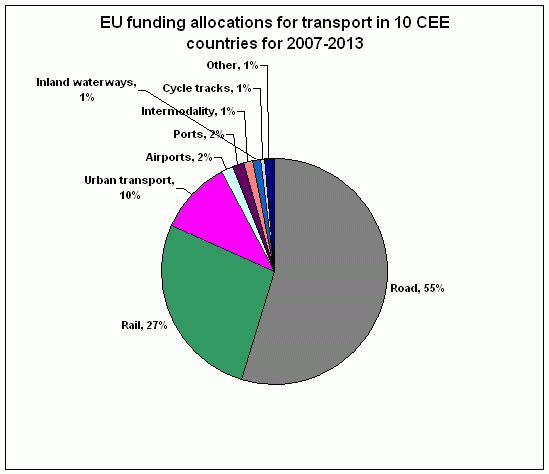Transport
Road bias in EU and EIB funding
The CEE countries undoubtedly need investment into rehabilitation and modernisation of their transport infrastructure. The question is, however, what kind of infrastructure should be prioritised. The balance chosen will have long-term implications for CEE countries’ greenhouse gas emissions and dependence on oil imports. The EU’s official sustainable development strategy demands reducing the growth of transport, shifting it from road to rail and modernising public transport. Yet the CEE countries are planning to spend twice as much EU funds for roads than for railways in the 2007-2013 period, while funding for public urban transport is set to be marginal. The EIB’s investments have been even more biased in favour of roads in recent years.

Advantages of railways and public transport:
- Railways and public transport consume less energy and emit on average three times less CO2 per passenger-kilometre than cars.
- In the case of freight transport, trains cause five times less CO2 emissions per tonne-kilometre than trucks.
- Buses and trams use 20 times less scarce urban space per passenger than private cars.
- The number of people seriously injured and killed per driven passenger-kilometre is 10-20 times lower for collective transport than for cars.
The one way subsidy street
Disproportionate spending on new motorways has been a constant in transport financing in the CEE region over the last 15 years. As motorway fees cover only a minimal part of their costs, public funds spent on them are in fact subsidising increasing volumes of car and truck traffic. At the same time, public transport and railways have suffered from chronic under-investment, leading to higher fares and a lack of funds for the improvement of services. The result has been a loss of their competitiveness vis-à-vis car and truck transport. It is no surprise that CO2 emissions from the CEE transport sector have surged by 35 percent over the last ten years.
More wealth does not need to mean more cars
Despite all this, the share of freight transported by rail and of passengers transported by public transport is still considerably higher in the new member states than in the old ones. The CEE countries still have a chance to make the right transport choices where Western Europe got it wrong in the past: car dependency, noise and air pollution, urban sprawl and chronic congestion can all be avoided with the help of smart investment of EU funding. Increased wealth does not need to be correlated with increased car dependency. Proof of this can be found in the German city of Freiburg where 60% of all trips are made using public transport, cycling or walking – thanks to careful urban development planning, high-quality service and appropriate pricing.
The need for proper transport strategies and environmental assessments
Reasonable development of transport infrastructure must be based on:
- adequate strategies and assessments of needs to ensure that the most necessary projects are realised; and
- high quality environmental assessments, so that people and the environment do not suffer due to the projects.
Deficiencies are too common
Most of the clashes outlined in this map would not happen if both transport strategies and environmental assessments were carried out correctly. Unfortunately, this is often not the case. In the Czech Republic, for example, transport projects are being built according to outdated plans drawn up more than 30 years ago, even though the government’s own analysis suggests that many of these projects are no longer a priority – a fact repeatedly criticised by the country's Supreme Audit Office. Environmental assessments (SEA procedure for plans and strategies and EIA procedure for individual projects) are often treated only as rubber-stamping exercises rather than important processes for selecting the best possible route and mitigating any negative impacts.
Building infrastructure responsibly
The CEE countries now have an opportunity to modernise their transport infrastructure in an environmentally sensitive and cost-effective way. This chance will be lost if they do not get the transport strategies and environmental assessments right. EU and EIB funding should be given only to those projects where these processes have been carried out properly.
Inland navigation does not require transforming rivers into canals
Inland navigation has an important role to play but should not justify the deepening, straightening and damming of free-flowing rivers:
- The transport function of rivers has to be balanced against all their other benefits and services including the support of valuable ecosystems, flood protection, recreation, fishing, and provision of drinking water, which are all threatened by the transformation of rivers into shipping canals.
- In fact, it is possible to improve navigation on rivers without costly and destructive engineering works - through the technological improvement of ships and more precise water level forecasting. Instead of investing lots of EU money into adapting rivers to deeper and deeper ships, ships should be adapted to rivers.
- Finally, inland navigation will not help reduce the number of trucks on motorways. Water transport usually does not compete with road transport for the same type of freight, while it does compete more directly with rail transport.

